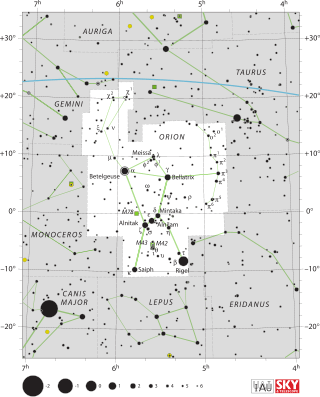Saiph

Location of Saiph (circled) | |
| Observation data Epoch J2000 Equinox J2000 | |
|---|---|
| Constellation | Orion |
| Right ascension | 05h 47m 45.38884s[1] |
| Declination | −09° 40′ 10.5777″[1] |
| Apparent magnitude (V) | 2.09[2] |
| Characteristics | |
| Spectral type | B0.5 Iab:[3] |
| U−B color index | –1.02[2] |
| B−V color index | –0.18[2] |
| Variable type | Slightly[4] |
| Astrometry | |
| Radial velocity (Rv) | +20.5[5] km/s |
| Proper motion (μ) | RA: +1.46[1] mas/yr Dec.: –1.28[1] mas/yr |
| Parallax (π) | 5.04 ± 0.22[1] mas |
| Distance | 650 ± 30 ly (198 ± 9 pc) |
| Absolute magnitude (MV) | –6.1[6] |
| Details | |
| Mass | 15.50 ± 1.25[7] M☉ |
| Radius | 22.2[6] R☉ |
| Luminosity | 56,881[7] L☉ |
| Surface gravity (log g) | 2.9[6] cgs |
| Temperature | 26,500[6] K |
| Rotational velocity (v sin i) | 83[6] km/s |
| Age | 11.1 ± 0.5[8] Myr |
| Other designations | |
Saiph (κ Orionis, 53 Orionis) is the sixth-brightest star in the constellation of Orion. Of the four bright stars that compose Orion's main quadrangle, it is the star at the south-eastern corner. A northern-hemisphere observer facing south would see it at the lower left of Orion, and a southern-hemisphere observer facing north would see it at the upper right. The name Saiph is from the Arabic saif al jabbar, 'سیف الجبّار' literally sword of the giant.[9] This name was originally applied to Eta Orionis.
In the 17th century catalogue of stars in the Calendarium of Al Achsasi al Mouakket, this star was designated Rekbah al Jauza al Yemeniat, which was translated into Latin as Genu Dextrum Gigantis "right knee of the giant".[10]
Parallax measurements yield an estimated distance of 650 light-years (198 parsecs) from Earth, which is about the same as Rigel.[1] However despite being a hotter star, it is smaller and less luminous than Rigel with an apparent visual magnitude of 2.1.[2] The luminosity of this star changes slightly, varying by 0.04 magnitudes.[4]
Compared to the Sun this is an enormous star, with 14–17 times the mass and over 22 times the radius. It has a stellar classification of B0.5 Iab:.[3] The luminosity class 'Iab' represents a supergiant star that has exhausted the supply of hydrogen at its core and evolved away from the main sequence. However, the ':' indicates some uncertainty in the spectral value. Saiph has a strong stellar wind and is losing mass at the rate of 9.0 × 10–7 times the mass of the Sun per year, or the equivalent of the Sun's mass every 1.1 million years.[6] Large stars such as Saiph (and many other stars in Orion) are destined to collapse on themselves and explode as Type II supernovae.[9]
Cultural significance
The Wardaman people of northern Australia know Saiph as the Guman digging stick, used to make a canyon by Black-headed Python.[11]
References
- ↑ 1.0 1.1 1.2 1.3 1.4 1.5 van Leeuwen, F. (November 2007), "Validation of the new Hipparcos reduction", Astronomy and Astrophysics 474 (2): 653–664, arXiv:0708.1752, Bibcode:2007A&A...474..653V, doi:10.1051/0004-6361:20078357
- ↑ 2.0 2.1 2.2 2.3 Crawford, D. L.; Barnes, J. V.; Golson, J. C. (1971), "Four-color, H-beta, and UBV photometry for bright B-type stars in the northern hemisphere", The Astronomical Journal 76: 1058, Bibcode:1971AJ.....76.1058C, doi:10.1086/111220
- ↑ 3.0 3.1 3.2 "SAIPH -- Variable Star", SIMBAD (Centre de Données astronomiques de Strasbourg), retrieved 2012-01-12
- ↑ 4.0 4.1 Lefèvre, L. et al. (November 2009), "A systematic study of variability among OB-stars based on HIPPARCOS photometry", Astronomy and Astrophysics 507 (2): 11411201, Bibcode:2009A&A...507.1141L, doi:10.1051/0004-6361/200912304
- ↑ Wielen, R. et al. (1999), Sixth Catalogue of Fundamental Stars (FK6). Part I. Basic fundamental stars with direct solutions (35), Astronomisches Rechen-Institut Heidelberg, Bibcode:1999VeARI..35....1W
- ↑ 6.0 6.1 6.2 6.3 6.4 6.5 Crowther, P. A.; Lennon, D. J.; Walborn, N. R. (January 2006), "Physical parameters and wind properties of galactic early B supergiants", Astronomy and Astrophysics 446 (1): 279–293, arXiv:astro-ph/0509436, Bibcode:2006A&A...446..279C, doi:10.1051/0004-6361:20053685
- ↑ 7.0 7.1 Hohle, M. M.; Neuhäuser, R.; Schutz, B. F. (April 2010), "Masses and luminosities of O- and B-type stars and red supergiants", Astronomische Nachrichten 331 (4): 349, arXiv:1003.2335, Bibcode:2010AN....331..349H, doi:10.1002/asna.200911355
- ↑ Tetzlaff, N.; Neuhäuser, R.; Hohle, M. M. (January 2011), "A catalogue of young runaway Hipparcos stars within 3 kpc from the Sun", Monthly Notices of the Royal Astronomical Society 410 (1): 190–200, arXiv:1007.4883, Bibcode:2011MNRAS.410..190T, doi:10.1111/j.1365-2966.2010.17434.x
- ↑ 9.0 9.1 Kaler, James B., "SAIPH (Kappa Orionis)", Stars (University of Illinois), retrieved 2012-01-27
- ↑ Knobel, E. B. (June 1895). "Al Achsasi Al Mouakket, on a catalogue of stars in the Calendarium of Mohammad Al Achsasi Al Mouakket". Monthly Notices of the Royal Astronomical Society 55: 429. Bibcode:1895MNRAS..55..429K.
- ↑ Harney, Bill Yidumduma; Cairns, Hugh C. (2004) [2003]. Dark Sparklers (Revised ed.). Merimbula, New South Wales: Hugh C. Cairns. p. 139. ISBN 0-9750908-0-1.
External links
| ||||||||||||||||||||||||||
Coordinates: ![]() 05h 47m 45.4s, −09° 40′ 11″
05h 47m 45.4s, −09° 40′ 11″